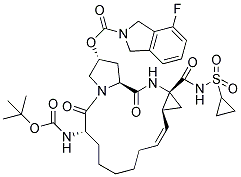All AbMole products are for research use only, cannot be used for human consumption.

ITMN-191 (Danoprevir, RG7227) is a potent and orally active inhibitor of hepatitis C virus (HCV) NS3/4A serine protease with an IC50 of 1.6 nM. ITMN-191 is shown to be a potent inhibitor of NS3 with a two-step binding mechanism. Progress curves are consistent with the formation of an initial collision complex (EI) that isomerizes to a highly stable complex (EI*) from which ITMN-191 dissociates very slowly. From progress curve analysis, the rate constant for dissociation of ITMN-191 from the EI* complex is 3.8 x 10(-5) s(-1) with a calculated complex half-life of approximately 5 h and a true biochemical potency (K(i)*) of approximately 62 pM. Abrogation of the tight binding and slow dissociative properties of ITMN-191 is observed with proteases that carry the R155K or D168A substitution, each of which is likely in compound resistant mutants. Slow dissociation is not observed with closely related macrocyclic inhibitors of NS3, suggesting that members of this class may display distinct binding kinetics.
| Cell Experiment | |
|---|---|
| Cell lines | Huh7 cells |
| Preparation method | The viability of Huh7 cells, human cardiac myocytes, and human cardiac fibroblasts was assessed following 72 h of exposure to ITMN-191 using a CellTiter-Glo Luminescent Cell Viability kit (Promega, Madison, WI). For these cell types, viability in the presence of ITMN-191 was fitted to a four-parameter logistic function to obtain a 50% cytotoxic concentration (CC50). Additionally, the CC50s were determined for six primary normal human cell types in stationary and proliferating (dividing) phases by Lonza, Inc. (Walkersville, MD). The cell types included normal human hepatocytes, microvascular endothelial cells, human skeletal muscle myoblasts, human articular chondrocytes, human lung fibroblasts, and renal proximal tubule epithelial cells. For the proliferating phase, ITMN-191 was added when cells reached 50% confluence. For the stationary phase, ITMN-191 was added 1 day after cells reached 100% confluence. Cell viability was quantified following 72 h of exposure to ITMN-191 using a ViaLight Plus kit on a microplate reader. CC50s were determined as described above. |
| Concentrations | 5 pM ~100 nM |
| Incubation time | 72 h |
| Animal Experiment | |
|---|---|
| Animal models | Sprague-Dawley rats and Cynomolgus monkeys |
| Formulation | water |
| Dosages | 30-mg/kg |
| Administration | oral gavage |
| Molecular Weight | 731.83 |
| Formula | C35H46FN5O9S |
| CAS Number | 850876-88-9 |
| Solubility (25°C) | DMSO ≥100 mg/mL Ethanol ≥100 mg/mL |
| Storage |
Powder -20°C 3 years ; 4°C 2 years In solvent -80°C 6 months ; -20°C 1 month |
| Related Proteasome Products |
|---|
| Proteasome inhibitor IX
Proteasome inhibitor IX (PS-IX; AM114) is a Chalcone derivative and a chymotrypsin-like activity of the 20S proteasome inhibitor with an IC50 value of ~1 μM. |
| NIC-0102
NIC-0102 is an orally potent proteasome inhibitor (pIC50=7.55) that specifically inhibits NLRP3 inflammasome activation.NIC-0102 showed potent anti-inflammatory effects in vivo in a DSS-induced ulcerative colitis model. In addition, NIC-0102 inhibited the production of pro-IL-1β. |
| Ac-WLA-AMC
Ac-WLA-AMC is a specific 20S constitutive proteasome β5 fluorogenic substrate. |
| Ac-Nle-Pro-Nle-Asp-AMC
Ac-Nle-Pro-Nle-Asp-AMC is a specific substrate for 26S proteasome. |
| PR-39
PR-39, a natural proline- and arginine-rich antibacterial peptide, is a noncompetitive, reversible and allosteric proteasome inhibitor. |
All AbMole products are for research use only, cannot be used for human consumption or veterinary use. We do not provide products or services to individuals. Please comply with the intended use and do not use AbMole products for any other purpose.


Products are for research use only. Not for human use. We do not sell to patients.
© Copyright 2010-2024 AbMole BioScience. All Rights Reserved.
